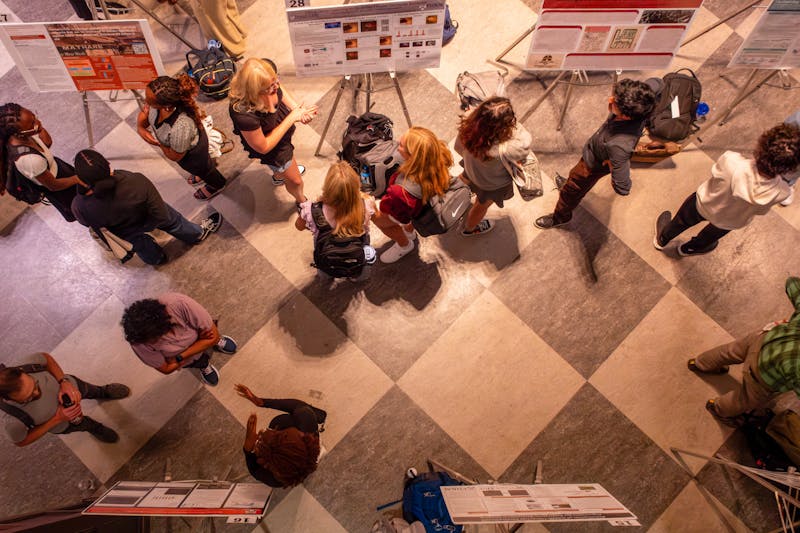
On the field, senior forward Lis Zandbergen, senior goalkeeper Frederique Wollaert, and sophomore forward Livia Loozen are a strong group. They each started all 17 games that Penn field hockey played this season, with Loozen scoring six goals to come in second on the team and Zandbergen adding three assists to her own pair of scores. In the net, Wollaert was a consistent presence for the Quakers, racking up a .744 save percentage and allowing under two goals per game.
Off the field though, these three have something else in common. They all hail from the Netherlands and came to the United States in order to pursue their athletic dreams with the Red and Blue.
The Netherlands is a hotbed for field hockey, as the game is among the most popular sports there. Currently, both the men’s and women’s teams are ranked as the best in the world in the most recent FIH World Rankings.
What this means is that the sport is very commonly played in families, which is exactly the path that both Zandbergen and Wollaert took to the game. Zandbergen’s brother played the sport, which convinced her mother that field hockey was good for her, while Wollaert also had a similar connection.
“There was a field that was pretty close to my house, and I always loved being outside with my brothers and playing field hockey with them,” Wollaert said. “So I feel like that’s how I got into field hockey in the first place, and I think because I started so early, the love for the game only increased from there.”
From there, one thing led to another, and Zandbergen found herself playing for club teams throughout her years of secondary education. During her teenage years, she found herself facing a fork in the road about whether — and where — to continue her athletic career. This time, though, the inspiration didn’t come from her parents, but from her teammates and herself.
“I’ve always been very willing to explore new countries,” Zandbergen said. “So in my junior year of high school, I started thinking about where I wanted to be [and] honestly my main thing was that I wanted to be in a different country … and then some of my friends who play for the same club team were going to the [United States], … [so I] became really excited by the opportunity to play for my university.”
But after making that decision, there was still a long way to go before they could suit up for the Quakers. Even though organizations like KingsTalent exist to collect video highlights, test scores, and other information about recruits on a centralized platform for coaches to view, it was still a lengthy process. In fact, Wollaert played for a school in the Netherlands for a year before coming to Penn.
Furthermore, according to coach Colleen Fink, the timeline for recruiting takes place later for international student-athletes compared to those from the United States. All of this was in addition to the presence of cultural differences with regard to the role athletics play in university life for student-athletes.
“I went to college in the Netherlands for a year and played for a club team there,” Wollaert said. “Then I transferred to Penn to play here. It was interesting to see that in the [United States] it is all more focused … like you would practice every day in the morning and then go to school. Whereas in the Netherlands it’s more like a leisure activity than really performing on a high level.”
Fink notes that given the increased role of field hockey in the Netherlands, athletes start younger and often have different skill sets than American players, which can sometimes require a learning curve for athletes coming to the American college system — both in terms of cultural adjustment and a different tactical style of how field hockey is played.
“I think [recruits] have a general understanding of college [and] … the infrastructure of American sport, but I don’t think they have a complete understanding of what it actually looks like day in and day out just because it’s not a part of their culture at all,” Fink said. “If you go across the globe, people can pretty clearly define how [different countries] play, so there’s definitely a huge learning curve from a stylistic approach that can be a little challenging at times, and especially in the beginning.”
But as they make this transition — and ultimately shape successful careers with the Quakers — these three have joined a robust community of Dutch athletes playing field hockey in the United States. Zandbergen has a close friend from her club team who now plays for Princeton, but most of all, they’ve found that the closest bond has been amongst themselves.
“Coming to a different country with a different language and different culture is a big step and it can be challenging at times,” Zandbergen said. “So having people who have a similar experience and speak the same language has been really fun and helpful. I’m thankful for them being on the team.”
The Daily Pennsylvanian is an independent, student-run newspaper. Please consider making a donation to support the coverage that shapes the University. Your generosity ensures a future of strong journalism at Penn.
Donate







